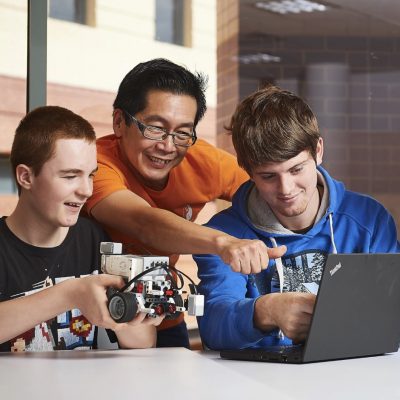Programs for teens with autism should promote strengths

— Program facilitators with shared interests crucial to program success —
— Peer mentoring key to building confidence, new skills —
The unique strengths of adolescents with autism – including attention to detail, loyalty and memory skills – should be the focus of employment programs to ensure they can play a crucial role in the workforce, the Bankwest Curtin Economics Centre’s latest report shows.
The BCEC report, A Strength-Based Program for Adolescents with Autism, examined the features that should be included in strength-based programs in order to deliver the most effective outcomes for young people living with autism.
The study observed and interviewed facilitators, parents and participants from three strength-based programs delivered by the Autism Academy for Software Quality Assurance (AASQA) CoderDojo at Curtin University, Autism West and Firetech Camp Australia.
Report author Curtin Professor Tele Tan, Director of AASQA, said the latest data from the Australian Bureau of Statistics suggested only 40.8 per cent of working aged individuals with autism participated in the labour force, compared to 83.2 per cent of people without disability.
“Many individuals with autism have abilities well suited to work in the information technology sector and developing programs that focus on these skills in a safe environment outside the classroom may assist in increasing employment rates of people with autism,” Professor Tan said.
“Our research found program facilitators played a large role in the experiences of the people taking part in the program, so program coordinators should place a strong emphasis on recruiting facilitators with shared interests to participants, such as coding and playing video games.
“We also found programs should take a multi-disciplinary approach to sourcing facilitators, bringing together individuals from the science, technology, engineering and health discipline areas, for example.”
Strength-based programs allow facilitators to tailor activities to individuals, and provide a higher level of autonomy for participants to complete activities.
“The programs we studied supported the existing strengths of adolescents with autism, while making allowances or alterations for specific health needs,” Professor Tan said.
“These approaches can both celebrate diversity and help to build better futures for young people with autism.”
Report co-author Mr Matthew Jones, PhD Candidate at the School of Occupational Therapy, Social Work and Speech Pathology at Curtin University, said the report also highlights the benefits that come from peer mentoring and providing a space for participants to share their successes.
“Peer mentoring emerged as a way participants could teach each other new skills, resulting in mentors building their own confidence and socialisation skills, and mentees learning new techniques,” Mr Jones said.
“We also observed that participants had a high level of anxiety when starting a new program, and this could be managed by providing clear expectations for the program, providing autonomy, reducing noise levels and providing plenty of physical space. Accommodating the individual needs of adolescents with autism was essential for creating a safe space and reducing anxiety.
“Once completing a program, participants were armed with the hard skills they may require for a career in information technology, coupled with the soft skills they would need in order to work with a diverse team within a structured workplace.”
BCEC Director Professor Alan Duncan said BCEC was proud to support research into programs that aim to benefit the lives of people living with autism, in line with the Centre’s mission to deliver research that improves the lives of West Australians and communities.
“Employment is a fundamental right for everyone and programs such as these give adolescents with autism the confidence they need to develop skills to excel at school, through to entry into the workforce,” Professor Duncan said.
The report will be launched at the 2018 annual AASQA awards ceremony on Tuesday 11 September.
Key findings from the report include:
Program facilitators
- In strength-based information and communication technology programs, organisations need to consider the personal traits of the facilitators and their ability to create a safe environment where the adolescents can engage in tasks autonomously.
- Facilitators should be recruited based on their field of expertise, while attempting to match these with adolescents’ areas of interest.
- Facilitators should be flexible and collaborative, and educated in adopting a person-centred approach (placing the person before the disability).
- Consistent attendance is integral for building trust with program participants and organisations should implement strategies to support facilitator retention.
- It is advantageous for relationship and rapport building if facilitators have experience in autism or another disability.
Program activities
- Programs should focus on improving existing skills or talents, or on developing new skills relevant to the career goals of the adolescent.
- Participants value program routine and structure, along with a greater choice in activities.
- Peer mentoring is a potentially effective approach to teaching new skills, but this requires ongoing facilitator support.
- Providing adolescents with an opportunity to showcase or demonstrate their technical skills to each other and their families was associated with a sense of pride and enhanced socialisation.
- Facilitators need to be educated in goal setting techniques and peer mentoring strategies.
- Activities need to be set at the right level of challenge and should incorporate specific adolescent interests.
- Flexibility within programs enabled facilitators to adapt to ‘the mood’ of students, motivating them and creating opportunities for autonomous learning.
- Other strategies identified with effective programs included managing expectations, focusing on visual learning strategies, and supporting adolescents to cope with failure.







